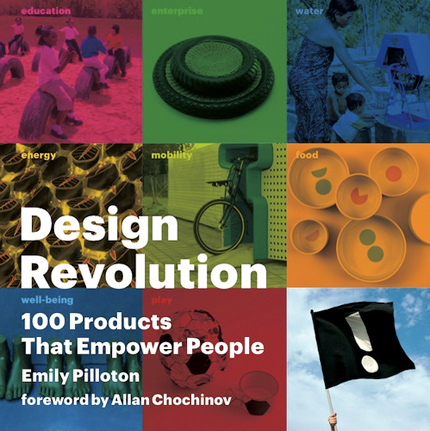
Cover of the book Design Revolution: 100 Products that Empower People by Emily Pilloton
Last year, at the age of 26, industrial designer Emily Pilloton set out to compile 100 thumbnail profiles of products that met her definition of empowering people: they are somehow customizable and superior to market competitors, while perhaps benefiting the planet as well as underprivileged communities. Pilloton is an Art Institute of Chicago–trained founder of a year-old nonprofit, Project H, which collaborates widely with NGOs to supply the likes of building materials, furniture and playground equipment to impoverished groups. (The H stands for “humanity, habitats, health and happiness.”) Her ambitions for this book are laudable, although her enthusiasms could use some stricter channeling.
She ended up compiling about 115 profiles of not only objects but also one-off sculptural installations, websites, apps, R&D initiatives and student concepts. Her choices date back to the 1920s (Maria Montessori’s stackable toys) and are organized into eight chapters, including “enterprise,” “well-being,” and “play.” (The lines between categories were clearly hard to draw: a zirconium replacement knee appears in “mobility,” while a polyethylene prosthetic foot qualifies for “well-being.”)
The target audiences range from starving families (Plumpy’nut food sachets) to rich campers (SylvanSport’s $7,995 pop-up tent on a trailer). In between such socioeconomic extremes are products for everyone who takes pills (Deborah Adler’s color-coded pharmacy bottles for Target) and anyone living off the grid and striving for self-sufficiency by collecting rainwater runoff and generating power via solar panels, wind turbines, foot pedals or coagulated vegetable oil.
Pilloton’s juxtapositions of self-indulgences and desperate necessities can be jarring — what are a $250 kinetic toy kit and a wavy schoolyard fence in Holland doing a few pages from LifeStraws that filter out the third world’s diarrhea-inducing parasites? But Pilloton’s goal, she writes, is to cover the many ways that designers can engage in “design processes that are respectful, generative, catalytic, and productive.” Those broad parameters, however, seem to have prevented her from delving very far in depth.
She sometimes leaves out basic background information, like when and where a product was launched, and she mentions hardly any drawbacks to the designs except for perhaps the “safety issues” of a DIY jar-mounted battery and the “dependence on a battery charge” of a distance sensor for blind pedestrians. Her prose often veers into PR speak, praising companies as industry leaders aiming to “enhance learning experiences” and “create connections between people and objects.”
No photo captions identify the locales of scene after scene of villagers in native dress, and there are virtually no quotes from users. Pilloton does quote designers, although with generic lines like “Design is a powerful tool that allows you to imagine a system that can be organic and enabling.” Pilloton’s 38-page introduction, meanwhile, is packed with gung-ho quotes from luminaries and footnoted 42 times. She cites Victorian landscape architect Frederick Law Olmsted’s advice on “considering distant effects and always sacrificing immediate success and applause to that of the future,” and Colin Powell’s maxim that “Perpetual optimism is a force multiplier.” But Pilloton’s own prose in the introduction can be hard to fathom: “By being formed through awareness, the solution carries more value and brings information, education, and understanding that subconsciously or consciously may inform an individual’s use and adaptation of the solution.”
This book will likely nonetheless sell reasonably well in the niche market of green design handbooks. Pilloton’s title and breezy approach are far less daunting and preachy than those of similar recent tomes, like Alex Steffen’s Worldchanging and Cameron Sinclair and Kate Stohr’s Design Like You Give a Damn. The layouts of Pilloton’s pages are friendly, too, with easily grasped chapter icons (a sun for “energy,” a bitten cookie for “food”) and lots of air space around the text. So there would have been plenty of room on the page for Pilloton to promote her favorite products more persuasively, by opening up debate and showing some skepticism.
